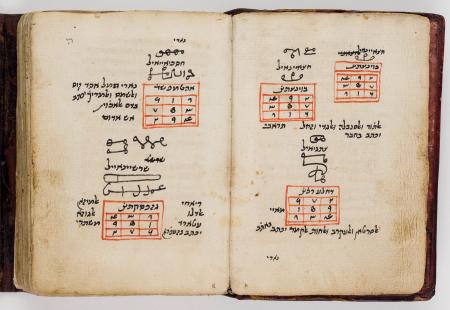Obj. ID: 32976
Hebrew Illuminated Manuscripts Judeo-Arabic Kabbalistic Manuscript, Yemen, 1851

The following description was prepared by William Gross:
"The writing of amulets was not uncommon in Yemen. This writing was done by persons considered holy, and they usually had their own manuscripts containing the formulae for such amulets and Segulot. These manuscripts were handed done through the generations and are often in more than one hand. This is a particularly finely written example, with both Hebrew and Arabic in Hebrew letters used in the text. The manuscript is divided into two sections. The first part of Kabbalah is written in Arabic in Hebrew letters from Moslem sources. On page 1 reverse is a graphic image for an amulet to create love between two people, very similar to two amulets by Yitzhak Cadoor that are in the Gross Family Collection. There are many other Kabbalistic illustrations in this section as well as the second part, which is entirely in Hebrew and identified as ""Sefer Raziel ha-Malach"", even though it is not the traditional text known today. It is the text from ""Sefer ha-Razim"", the earliest book know dealing with practical Kabbalah. It is clear that Salem was an accomplished scribe, both in Hebrew and Arabic. The manuscript is bound in a Koran type binding of tooled leather. Sefer HaRazim (Hebrew: ספר הרזי×‎, ""Book of Secrets"") is a Jewish magical text supposedly given to Noah by the angel Raziel, and passed down throughout Biblical history to Solomon, for whom it was a great source of his wisdom, and purported magical powers. Note that this is a different book than the Sefer Raziel HaMalakh, which was given to Adam by the same angel, but they stem from the same tradition, and large parts of Sefer HaRazim were incorporated into the Sefer Raziel under its original title. This is an unorthodox text; while traditional Jewish laws of purity are part of the cosmogony, there are ""praxeis which demand we eat cakes made from blood and flour"" (Morgan 9). It is thought to be a sourcebook for Jewish magic, calling upon angels rather than God to perform supernatural feats. The text itself was once considered to be part of ""orthodox"" Judaism under the influence of Hellenism, but this text, along with some other works, are considered to be unorthodox or heretical in modern Judaism.
Pages: 201"





















